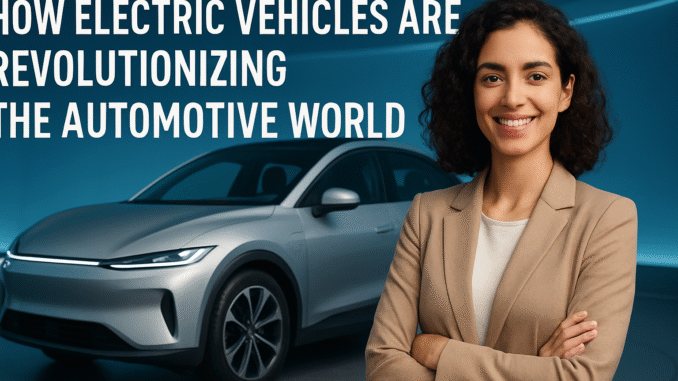
How Electric Vehicles Are Revolutionizing the Automotive World
The automotive industry is undergoing a historic transformation, and at the center of this shift is the rise of electric vehicles (EVs). What was once a niche market limited to experimental models has now become a global movement that is reshaping transportation, energy consumption, and even city planning. Electric vehicles are no longer just an alternative; they are quickly becoming the future of mobility.
This article explores how electric vehicles are revolutionizing the automotive world, examining their impact on technology, the environment, the economy, and the way we think about cars.
1. The Rise of Electric Vehicles
The shift toward EVs has been building momentum over the last decade, but in recent years, adoption has accelerated dramatically. Governments are setting deadlines to phase out fossil fuel-powered vehicles, while consumers are showing growing interest in sustainable alternatives.
By 2025, global EV sales are projected to exceed 20% of all new car sales, and that number will continue to grow as charging infrastructure improves and battery costs decline. Companies like Tesla, BYD, General Motors, Hyundai, and Volkswagen are investing billions in EV production, making it clear that this trend is permanent.
2. Environmental Benefits Driving Adoption
One of the biggest reasons behind the EV revolution is the urgent need to address climate change. Traditional gasoline and diesel vehicles are responsible for significant greenhouse gas emissions, contributing to global warming and air pollution.
EVs provide a cleaner alternative:
- Zero tailpipe emissions help reduce air pollution in urban areas.
- When paired with renewable energy sources, EVs can drastically cut carbon footprints.
- Improved energy efficiency—EVs convert over 60% of the electrical energy from the grid into power at the wheels, compared to only 20–30% efficiency in internal combustion engines.
This makes electric vehicles a critical solution for countries aiming to achieve carbon neutrality.
3. Breakthroughs in Battery Technology
Battery innovation is one of the most important drivers of the EV revolution. Early EVs suffered from limited ranges and long charging times, but modern advancements are changing that narrative.
Key improvements include:
- Lithium-ion battery efficiency: Costs have dropped more than 80% over the past decade.
- Solid-state batteries: Offering higher energy density, faster charging, and better safety, these are expected to hit the market in the mid-2020s.
- Extended driving ranges: Many new EVs now offer ranges above 400 kilometers (250 miles), with premium models exceeding 600 kilometers (370 miles).
- Fast charging technology: Public charging stations now provide up to 80% charge in as little as 20–30 minutes.
These innovations are making EVs practical for both daily commuting and long-distance travel, removing one of the biggest barriers to adoption.
4. Charging Infrastructure Expansion
The success of electric vehicles depends on reliable charging networks. Governments and private companies worldwide are rapidly building charging stations to meet growing demand.
The future of EV charging includes:
- High-speed DC fast chargers along highways, enabling long road trips.
- Home charging solutions, allowing owners to conveniently recharge overnight.
- Wireless charging systems in development, which could allow cars to charge while parked or even while driving on specially equipped roads.
- Smart charging networks that balance energy usage with renewable power grids.
As infrastructure expands, the fear of “range anxiety” is fading, making EV ownership more appealing to mainstream consumers.
5. Autonomous Driving and EVs
Electric vehicles and autonomous driving technology often go hand in hand. Many automakers are pairing EV platforms with advanced driver-assistance systems (ADAS) and self-driving features.
Why EVs are ideal for autonomy:
- Their electronic systems are easier to integrate with AI and sensors compared to traditional vehicles.
- Instant torque and precise control make them suitable for automated driving algorithms.
- Over-the-air (OTA) updates allow automakers to continuously improve performance and safety features.
In the near future, fleets of autonomous EV taxis could reduce the need for personal car ownership, especially in urban areas.
6. Economic Impact on the Automotive Industry
The rise of EVs is also transforming the global economy. Traditional car manufacturing has long relied on oil, steel, and mechanical components. EVs, however, shift the focus to batteries, semiconductors, and renewable energy.
Key economic changes include:
- Job creation in new industries, such as battery production and charging infrastructure.
- Disruption of oil markets, with decreasing demand for gasoline and diesel.
- Increased competition among automakers, forcing them to innovate or risk falling behind.
- Supply chain adjustments, as raw materials like lithium, cobalt, and nickel become critical to production.
This shift is creating both opportunities and challenges for economies around the world.
7. EVs Redefining Car Ownership
Electric vehicles are changing how people think about owning cars. With fewer moving parts, EVs require less maintenance, reducing long-term ownership costs. No more oil changes, exhaust repairs, or complex engine servicing.
In addition, new ownership models are emerging:
- Car subscriptions where users pay a monthly fee for access to EVs.
- Ride-sharing and EV fleets, reducing the need for individual ownership.
- Vehicle-to-Grid (V2G) technology, where EVs can feed energy back into the power grid, turning cars into mobile batteries.
This shift means vehicles are becoming more than transportation—they are turning into integral parts of the energy ecosystem.
8. Influence on Urban Planning and Smart Cities
As EVs become mainstream, cities are rethinking infrastructure and transportation strategies. Urban areas are beginning to adopt:
- Low-emission zones where only EVs are permitted.
- Smart parking systems with integrated charging facilities.
- Electric public transport fleets, including buses and delivery vehicles.
- Green mobility solutions, encouraging cycling, walking, and shared EV services.
The transition to EVs is helping cities become cleaner, quieter, and more efficient, improving the quality of urban life.
9. Consumer Perception and Lifestyle Shifts
For many consumers, electric vehicles represent not just a mode of transportation but also a lifestyle choice. Owning an EV reflects values of sustainability, innovation, and progress.
- Younger generations, especially Millennials and Gen Z, are more likely to choose EVs.
- Luxury automakers are producing stylish EVs that combine performance with eco-consciousness.
- Awareness campaigns are making people more familiar with EV benefits, such as reduced fuel costs and environmental impact.
As adoption grows, EVs are becoming symbols of modern living.
10. The Future Outlook of EVs
The revolution is just beginning. By 2030, analysts predict that EVs could account for 40–50% of all new car sales globally. Countries like Norway are already leading the way, with EVs making up more than 80% of new car sales.
Future developments to expect:
- Affordable EVs priced competitively with gasoline cars.
- Improved recycling systems for batteries to ensure sustainability.
- Integration with renewable energy grids, creating a cleaner energy cycle.
- Smart EV ecosystems, where vehicles interact with cities, homes, and devices.
The electric revolution is not only transforming cars but also the way we live, work, and interact with technology.
Conclusion
Electric vehicles are not just a new type of car—they represent a fundamental shift in the way the automotive world operates. From reducing emissions and reshaping economies to influencing urban planning and changing lifestyles, EVs are driving a global revolution.
With advancements in battery technology, autonomous systems, and charging networks, the future of EVs looks brighter than ever. By choosing electric mobility, we are not only embracing innovation but also investing in a cleaner, smarter, and more sustainable future for generations to come.

